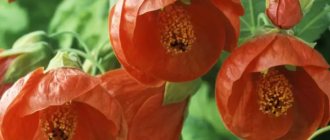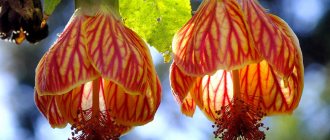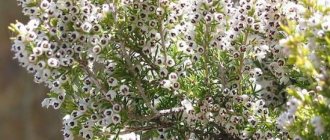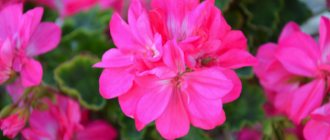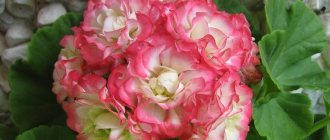Review: Seeds Aelita “Hybrid Abutilon. Juliet" color mixture – Beauty from a seed
Hi all!
Anyone who has already read my reviews knows that I am passionate about floriculture. And that includes anyone growing indoor plants from seeds. This time I decided to grow a homemade abutilon maple. This is a wonderful unpretentious plant. It grows quickly from seeds and blooms early with the most beautiful colorful bells. By the way, if you have two abutilon seeds of different colors grown from seeds, then you can cross-pollinate them and get homemade abutilon seeds of a completely new color. A most exciting activity, isn’t it!?) I’ll say right away that this is not the first time I’ve planted abutilon. I already grew it from seeds at the dawn of my passion for floriculture. Cute little plants grew and even bloomed. That's when I fell in love with them! But then, for some reason, unfortunately, they died. So, I decided to grow tender homemade maple again. Since I do not have the best attitude towards the Gavrish company (my experience in growing dracaena and lantana from this company Gavrish), when I saw Aelita brand abutilon seeds on sale, I made a choice in their favor. Although, taking into account the good germination of abutilon seeds in themselves, I can assume that Gavrish seeds would also germinate. But this is just a guess. So, I had in my hands a bag of Abutilon hybrid Juliet (a mixture of colors).
The manufacturer promises us early, long-lasting and abundant flowering of the large-flowered hybrid.
On the back of the package, as usual, there is brief information about the plant and planting recommendations.
In total there are 0.1 grams of seeds in the package, which is about 5 pieces.
The manufacturer recommends sowing the seeds in February-March in loose soil, to a depth of 0.5 cm. Before planting, soak until they swell. I did just that, sowed the seeds in loose soil, in a greenhouse and on a bright windowsill. The seeds germinate well, but not well. And in the process of growth, some are ahead of others. So, I got 4 abutilons. Two are larger, the other two are babies, not very strong at the moment. The photo shows one of the large sprouts (to be more precise, medium in size).
I placed them in different cups. I keep it on a bright windowsill and believe in the miraculous influence of spring and the spring sun on the development of flowers. My beauties haven't bloomed yet. But, I hope, until this moment there is very little time left. I’ll try not to forget and add photos of already blooming abutilons to the review. To summarize, I will say that I am quite pleased with these seeds from Aelita, good germination, low price. Anyone who wants a flower miracle on their windowsill, feel free to buy abutilone seeds from this company.
Beautiful window sills and a great mood to everyone!
Abutilon, indoor maple, rope plant - all these are the names of an amazing indoor plant that combines unpretentiousness and long-term abundant flowering. Fast growth and beautiful foliage complement the pleasant impression and make this flower a desirable specimen in many collections.
Abutilon received the name “indoor maple” due to the external resemblance of the leaves to maple leaves.
The flower is called rope flower because in its homeland, fiber is obtained from the stems of certain species, from which ropes and ropes are made.
Under natural conditions it grows in the tropical and subtropical climates of Africa, Asia, America and Australia. Represents the Malvaceae family.
In its natural habitat, the plant species may appear as an herbaceous plant, shrub, or small tree.
In the section you will see a photo of abutilon (indoor maple), as well as its types and varieties (megapotamian, Bella, Juliet, Bellevue, etc.).
Diseases, pests and ways to combat them
Although butylone can grow in rather difficult conditions, however
on its development. First of all, we are talking about temperature fluctuations, changes in lighting, and strong drafts, which can cause leaves to fall.
Stunted growth can be explained by a deficiency of nutrients in the soil or improper irrigation.
Seeing that the leaves have begun to turn yellow or have changed their usual color, it can be assumed that the house maple tree needs increased lighting. To do this, you will have to find him another room where there is more light. However, it is not recommended to make such drastic changes in cultivation; everything should happen gradually, and this will require shading.
Types and varieties
The leaves of indoor maple are large, carved, with three or five lobes. Their color is green, spotted or mottled. Flowers can be single or double, single or bicolor, on long stalks. The colors are very different: white, red, pink, orange, burgundy, gold. The shape of the flowers resembles bells or Chinese lanterns.
About 150 types of abutilone are known . Hybrid varieties bred on the basis of these species are also grown indoors. The most common varieties of indoor maple are:
- Abutilon Juliet is an unpretentious and fast-growing hybrid variety. Has large green leaves and large flowers;
- Abutilon Sello - has leaves on branched, slightly pubescent shoots, flowers with pink veins;
- Abutilon Darwin - has a spectacular appearance: large orange flowers with dark veins and bright green velvety leaves;
What you should know before buying indoor abutilone
When buying rope plant, you need to know the main characteristics of the plant:
| Mature plant size | Depends on the variety: regular varieties grow up to 1.5-2 m, and compact varieties up to 30-60 cm |
| Lifespan | 5 years, after which the plant loses its appearance and requires updating |
| Bloom | From April to September, flowering is abundant, the buds have different shapes, in diameter from 4 cm to 10 cm |
| Aroma | No smell |
| Safety | Safe |
| Difficulty of care | Low, unpretentious flower |
| Uniqueness | Depends on the species, some varieties are common |
| Where can I buy | Russia: vip-flowers.org; miltoniya.ru; abutilon.ru Belarus: flowersland.by; semenavminske.by; dolinasad.by Ukraine: iflowers.com.ua; florium.ua; domicad.com.ua USA: plantdelights.com; etsy.com |
Abutilon hybrid Juliet: botanical characteristics, how to grow
Decorative indoor maple (abutilon) is an evergreen shrub, actively used in the decoration of residential and office premises, greenhouses, and halls. One of its varieties, the Abutilon Juliet variety, is especially popular due to its unpretentiousness, rapid growth and beautiful appearance. It is ideal for indoor growing because it does not require intense lighting and yet blooms profusely all year round.
Rules for planting Abutilone
Even with all the undemandingness and ease of care, there are some basic principles and rules that are oriented towards when planting abitulon. To grow a healthy and beautiful plant you need:
- Select varieties correctly. For growing maples in residential areas, modern hybrid low-growing species are chosen. It is better to avoid greenhouse tall and small-flowered ones.
- Choose the most suitable location for growing. Indoor maple can adapt to any conditions, but lighting from the south-east or south-west is perfect.
- Prepare breathable, loose soil. For planting, universal compositions are used, which consist of peat and a large number of special baking powders.
- Purchase a container that is large and most suitable for the root system. The first planting of a seedling is carried out in a small pot, but according to the degree of growth and development of the roots, the plant is transferred to a large vessel.
Abutilon Juliet color mixture: description of the plant
Abutilon Juliet (abutilon Juliet) is a large-flowered hybrid bush plant that grows up to 150 cm in height. It has a high growth rate: the shoots increase annually by about 50 cm. The leaves of this abutilon are large, up to 15 cm in length, with carved edges, in shape similar to maple foliage of rich green color. Hence the second name of the plant - “indoor maple”.
The genus of domestic maple belongs to the malvaceae family. It grows naturally in the tropics and subtropics, where it is warm and humid. There it grows in the form of bushes, small trees or perennial grass and has more than 100 species.
With proper care, the hybrid abutilon Juliet grown from seed blooms at 4 or 5 months of life. With sufficient lighting, flowering occurs all year round. The flowers are bell-shaped, looking down, the diameter of the wide part is about 5-6 cm. The color of flowers in different shrubs can be pink, red, orange, bright yellow. If two shrubs with flowers of different colors have grown, then they can be crossed through cross-pollination and get Juliet with flowers of a new color.
The variety is unpretentious, loves light, but not too intense. With minimal care, even a novice gardener can grow a strong, profusely flowering plant without any problems.
The most common types of abutilone
This flower is quite diverse, because it includes many interesting varieties that can become a worthy decoration in the house.
Abutilon Sello
A characteristic feature of this hybrid variety is the presence of striped leaves. The domestic maple has a weakly branched stem, which produces straight, slightly hairy shoots. The leaves have three elongated lobes with a pointed tip.
This variety is decorated with light purple flowers with pink veins. The flowering time begins in mid-summer and continues until the first frost. When favorable conditions are created, plants can reach 2 m in height.
Abutilone hybrid
This is one of the brightest representatives of American hybrids, which includes many varieties. Most often it grows in the form of an evergreen shrub with brownish bark. The leaves have an unusual appearance, often three-lobed or five-lobed. Pubescence is present not only on the leaves, but also on the flowers, which are shaped like a bell.
Abutilone Darwin
Despite the fact that this variety has pronounced decorative properties, it is not so often found in the apartments of flower growers. During the growing season, this species produces
, which are supported on long petioles located on silky shoots with pubescence, growing up to 1 m in length. The leaves located in the lower part of the stem can have a seven-lobed shape. The blade located in the middle is usually very elongated. The flowers are bell-shaped, orange with red veins. No more than 3 inflorescences can grow from one axil. This variety of abutilon begins to bloom in the first weeks of April, and the inflorescences wilt at the end of September.
Abutilon Juliet
This variety stands out from others due to its high unpretentiousness. It is also of interest due to its rapid growth, since it can add up to 5 cm per season. Abutilon Juliet is ideal for growing indoors due to its undemanding nature in terms of lighting, and its flowers last throughout the year. The flowers are quite large, reaching a diameter of approximately 6 cm. When growing this variety by sowing seeds, the first flowers can only be expected after 5 months.
Abutilon Juliet: growing from seeds
Growing this abutilone from seeds is convenient because the germination rate of the variety is almost 100 percent. Most often, store-bought seeds of a “mixture of colors” are used for sowing. Sowing is carried out at the end of February or beginning of March.
Pre-sowing soil preparation is required. The soil is sifted to give it a looser and more moisture-absorbing structure, and treated with a solution of potassium permanganate to destroy possible fungal and bacterial infections. The optimal soil for abutilons includes peat, humus, river sand and vermiculite in a ratio of 2:2:1:1.
Abutilon is propagated by seeds and semi-lignified cuttings. Non-variegated forms of abutilon are propagated by seeds, since during seed propagation the parental characteristics are split.
For sowing you need to choose high-quality hybrid Juliet seeds with an intact dark-colored shell. Abutilon seeds with a damaged shell usually do not germinate. Before placing in the soil, the achenes selected from the mixture are soaked for 12 hours in warm water. You can make a growth stimulant solution for soaking.
Seeds of future abutilons are immersed in the soil to a depth of approximately 5 mm. The pot is covered with film and placed in a warm, illuminated place. Shoots should be expected after 3 weeks.
After the first maple leaf appears, the seedlings can be picked. For better growth of the transplanted plant, take a container no larger than 7 cm in diameter. After transplantation, young abutilons are cared for in the usual way: they monitor the sufficiency of lighting, soil moisture, and air temperature. Fertilize the soil once a month.
Shrubs grown from a mixture of seeds are stronger and more resilient than hybrid plants obtained by cuttings or propagation by leaves. It is noteworthy that the color of their flowers is more juicy and rich.
Seed preparation and sowing
Sowing work for growing indoor maple can be done almost all year round, but to obtain the highest quality seedling material, it is best to sow the seeds in early spring. For planting, it is recommended to use the largest and most undamaged seeds that have been calibrated and sorted.
Competent pre-sowing preparation, which consists of soaking, is mandatory. It is advisable to distribute the seed onto tissue that is abundantly moistened in a solution based on growth stimulants in the form of humic acids, Epin or Heteroauxin preparations. The average soaking time is about twelve hours , after which the seeds are placed in clean water at room temperature until they swell or germinate. The planting material prepared in this way is sown in a nutrient mixture prepared in advance and disinfected in the oven.
Before sowing, the planting soil must be moistened very well, the seeds must be distributed at a distance of a couple of centimeters from each other and sprinkled with soil, the layer of which should not exceed 5 mm. The container with the crops should be covered with a transparent plastic film and placed in a room with a temperature regime of 20-22°C. Before mass shoots appear, daily ventilation and spraying with settled warm water from a spray bottle are carried out. The average time from sowing to the appearance of seedlings can vary within two to three weeks.
Features of planting and care
It is not difficult to grow abutilon if you follow some simple rules. The bush should be kept indoors where there is enough light, but direct intense sunlight does not fall on the shoots. In warm months, the abutilon bush can be taken out onto the veranda or balcony, placed in a corner where direct sun does not penetrate. If there is insufficient lighting, the plant will not die, but it is unlikely to bloom.
During the summer months, the ideal air temperature in the growing area is between +20 and +25°C. In the cold season, Juliet can easily withstand temperatures from +10 to +15°C. But if Abutilon is forced to remain at a temperature below +10°C for a long time, then the shoots begin to dry out.
In the summer season, during the period of active growth and flowering, regular abundant watering is required. The water that accumulates in the pan is poured out. If the soil is poorly moistened, the shrub may shed its leaves and flowers. If the air is hot and dry, then spraying is necessary. The plant is sprayed carefully, the spray should not get on the flowers. From the end of autumn they switch from heavy watering to moderate watering, which continues until the end of winter.
The bushes are fed with mineral fertilizers and organic matter. Feeding is carried out once a week in the warm season. In the first weeks of spring, the application of nitrogen is preferable, and during the period of active flowering, potassium and phosphorus are recommended. During the winter season, fertilizing is not carried out.
To obtain a beautiful and neat crown from a hybrid abutilon, pruning is carried out periodically. The top of a young plant is plucked off to start the process of branch formation. In an adult Juliet bush, shoots are cut off by 1/3 or 2/3 of their length every year, in early spring. Abutilon grows quickly, and timely pruning not only allows you to form a neat crown, but also makes flowering abundant and the color of the flowers brighter.
From the first year of life, the plant must be replanted annually, each time choosing a larger pot. Flowering begins when the roots fill the entire soil.
Possible problems during cultivation
Despite the not particularly high requirements for growing conditions, problems can arise with abutilone. So, with a sudden change in lighting or temperature, a flower may shed its leaves. The same thing can happen if the earthen clod is overly dry. If a flower lover notices that the abutilon leaves are turning yellow, it makes sense to place it away from drafts, but closer to the light source. But the drying of their tips may indicate dry air in the room.
Indoor maple can be attacked by aphids, scale insects and spider mites. They can be detected by the appearance of spots in the form of dots, thin cobwebs or deformations on the leaf blades. Scale insects are visible to the naked eye - they usually live on the petioles of leaves or on stems, and look like a tiny shell tightly glued to the plant.
You can fight them with folk or store remedies:
- place the flower under the shower, and then thoroughly soap the leaves and stems with laundry soap, which should be washed off after 5-10 minutes;
- treat the plant with Decis solution according to the instructions;
- in case of mite infestation, the flower is treated with an acaricide and the humidity in the room is increased;
- treat the plant with Actellik according to the instructions;
- spray the plant and the surface of the soil in the pot with a strong infusion of garlic with the addition of soap;
- spray the flower with infusion of wormwood or tomato stems.
Reviews of Abutilon Juliet
It is believed that Abutilon relieves nervous tension, improves the mood of household members, calms the soul, awakens inspiration and promotes pleasant communication.
In flower shops, the seeds most often sold are “Abutilon hybrid Juliet mixture of colors” from. Customer reviews of this abutilone are extremely positive. Among the advantages of the variety are high germination rate, rapid growth, resistance to different environmental conditions, and low price. Buyers do not find any shortcomings.
Hybrid abutilone: growing from seeds, home care
Abutilon may not be one of the most popular ornamental plants, but more and more people are beginning to notice the beauty of this small bush. Undoubtedly, the hybrid cable car will decorate not only the apartment, but also the terrace and garden. Its decorative appearance is due to large, bright flowers, as well as leaves.
Hybrid abutilon (Abutilon x hybridum) belongs to the Malvaceae family. Its natural habitats are found in the forests of South America (Brazil).
The genus Abutilon includes more than 100 species of very diverse plants (shrubs, subshrubs, herbaceous plants), which reach a height of several meters. When growing at home, we mainly encounter hybrid forms of hybrid abutilon (Abutilon x hybridum) and megapotamian abutilon (Abutilon megapotamicum) - with drooping shoots. In our climate they are grown as houseplants.
Indoor maple is characterized by an elevated structure, green shoots, sometimes woody at the base. The bush is fast growing. In their natural habitat, shrubs can reach 3 m in height; home-grown specimens, depending on the variety, can reach a little over a meter in height, and, as a rule, lower. Very decorative leaves, shaped like maple leaves. Depending on the variety, the number of lobes varies - from three to seven. Color ranges from bright green to variegated with white or yellow spots. Numerous bell-shaped flowers appear in spring and bloom until late autumn. Flowers planted on long petioles, depending on the variety, delight with red, orange, white, pink, yellow flowers. The diameter of the flower can reach 8 cm. The seeds are dark and kidney-shaped.
With proper pruning, abutilon can be formed into a small tree.
There are a wide variety of varieties available for sale, so it’s worth looking around and choosing the most suitable variety.
The popular Bella series includes colorful forms with large flowers, up to 7 cm in diameter.
- "Red" with burgundy flowers,
- "Deep Coral" with coral flowers,
- "Apricot Shades" with apricot flowers,
- "Salomon Shades" with salmon-colored flowers.
It is worth noting that these are dwarf forms, approximately 45 cm high.
The following varieties will please you with yellow color: “Canary Bird”, “Golden Fleece”, and “Cannington Carol”, “Cannington Sally” with spotted leaves. The "Ashford Red" variety blooms red. A particularly beautiful variety is “Savitzii” with decorative white-edged leaves.
At the moment, the popular abutilon hybrid Juliet is a mixture of colors , a mixture of varieties of different colors, and the Bellevue variety is a mixture of colors, a shrub 90 cm high, blooms in summer-autumn. Maple green leaves. The flowers are large and of different colors.
Varieties with variegated leaves are the result of infection of abutilon by viruses . The presence of the virus in the cells does not significantly affect the growth of the plant; it may slow down the growth slightly. Indoor maple with spotted leaves looks original.
How to care for abutilone
As already mentioned, abutilone loves light very much, and only slightly less loves water. In addition, the active growth of home maple is simply impossible without decent nutrition. This active growth also needs to be contained and directed. Otherwise, in a couple of years the pretty maple will simply drive you out of the apartment. After all, he needs a lot of space.
Abutilon should be watered a lot and often at this time, twice a day, morning and evening. But still drain the excess water from the pan.
During winter dormancy, watering should be reduced. Please note that coolness and too wet soil can lead to root disease and plant death.
Abutilon is a well-known food lover. It must be fertilized from March to the end of October, every week. Domestic maple will absorb any mineral fertilizer for flowering plants; dilute it in a higher concentration than stated in the instructions. When buds are being laid, you can use fertilizers high in potassium and phosphorus. If there is not enough nutrition, the leaves and flowers of starving abutilon become deformed.
Abutilons begin to bloom very early. Indoor maple cuttings bloom a month after rooting, seedlings - four months after germination. This is an amazing phenomenon. Abutilon flowers appear at the end of the shoot. The first buds have appeared, and the shoot continues to grow. And from the new axils near the young leaves flowers grow again and again.
Indoor maple blooms for a long time, from April to November. But if not cared for properly, problems can arise.
Please note that buds form only on young shoots. Therefore, pruning, which enhances branching, is a prerequisite for flowering.
Requirements
Hybrid abutilone grown at home should be placed in a bright room (south window), this will guarantee lush flowering. Since abutilon can be grown on the balcony and terrace, it is worth using this option, especially since the plant likes fresh air during its lush growth. In the fresh air, it is better to provide a secluded place, sheltered from the scorching sun. Abutilon also grows in partial shade, but in such a place it will not pamper us with too lush flowering.
The room temperature during the growing period is 16-22 °C, in winter it is definitely below 10-15 °C.
The soil is fertile, humus, permeable and rich in nutrients. You can use a universal substrate for potted flowers.
Abutilon care includes watering, fertilizing, replanting, pinching and wintering.
Watering is a very important procedure for caring for abutilone at home, especially during the growth period and when grown in a sunny place. The plant in such conditions needs a lot of moisture. The frequency of watering depends on many factors, but it may turn out that you will have to water the plant daily, when grown outdoors in the ground, during periods of drought, even twice a day. When grown indoors, abutilone should be provided with good drainage because it does not like water. During winter, the soil should not be constantly wet; on the contrary, between the first and second watering the soil should dry out slightly.
During the growing season, abutilon is fertilized every 7-14 days with a multicomponent liquid fertilizer in accordance with the manufacturer's recommendations. In winter they do not fertilize.
The leaves are cleaned by washing off the dust with warm, soft water, being careful not to spray the flowers.
Conditions required for indoor maple
For experienced gardeners, indoor maple is of interest due to its ease of care. However, as with all other plants, there are rules that must be followed. Although light is beneficial for abutilone, it should not be too bright. Therefore, in summer it is recommended to grow it on the balcony, providing shading. It is necessary to carry out regular spraying of the crown. This measure will help stimulate growth.
In order for the butylon to bloom profusely every season, you will have to regularly replant it into a suitable container. Abutilone can bloom only when the root system thoroughly envelops the entire soil. This must be taken into account, and therefore the containers used for transplantation should not differ much in volume from the previous ones.
Soil selection
The plant feels best in a pot filled with universal potting soil. In some cases, homemade soil is also suitable, for the preparation of which you will need the following substances:
- Leaf soil, peat and sand in equal quantities;
- Two parts turfy clay soil, one part humus, one part leaf soil and one half part sand.
Spring and summer are important periods in the life of indoor maple, since at this time it actively grows and enters the flowering phase. For this reason, at this time of year, caring for the plant requires abundant watering.
- after the next watering, wait several hours, and then drain the excess moisture from the pan;
- You especially need to carefully monitor the soil moisture, because if it remains without water for too long, this can cause leaves and flower stalks to fall off;
- in November there is a decline in plant activity, so abutilon is switched to a moderate watering regime until February.
Top dressing
You can satisfy the need of abutilone for the nutrients it needs by applying mineral fertilizers. Feeding should be done from March to September. The addition of slurry also has a positive effect.
Reproduction and cultivation
To obtain new home maple bushes, you can use the method of sowing seeds and cuttings. The first method is quite effective and can be used for any variety that has green leaves.
Cuttings
The propagation method by cuttings can be used for any varieties of abutilon. However, it is primarily effective for plants with variegated leaves. It should be noted that when using the method of sowing seeds, it is impossible to transfer the properties of the mother plant to the new plant.
Abutilon can be grown from cuttings at any time of the year. However, experts recommend doing this in March: for this they use herbaceous cuttings, having previously torn off the flower buds from them. During the summer, it is recommended to plan this operation for August. It is better if abutilon is propagated using semi-lignified cuttings.
- first you need to prepare cuttings, which should have a length of no more than 12 cm. After this, you need to tear off the buds and lower leaves. A substrate based on sand and peat is used as a soil mixture for rooting;
- Having finished planting the cutting, you need to place a jar on the container or stretch plastic wrap. It is imperative to create an optimal temperature regime in the room, which should correspond to a temperature of 25 degrees. In addition, plantings need ventilation, watering and spraying. Most often, planting material takes quite a long time to take root, taking at least one month;
- when the cuttings have formed a good root system, they are transplanted into individual containers with a diameter of up to 7 cm. Subsequently, when growing young abutilon plants, the same rules are followed as in the case of adult plants.
When and how to trim abutilon?
When caring for indoor maple, you need to take into account that it grows extremely quickly. Therefore, pruning is necessary in the spring. This operation is carried out even before the shoots begin to grow, removing them by three or two thirds of their length. The exact distance can be determined based on the size of the bush or tree. As a result of pruning, the tree can be given an attractive and compact appearance, as well as provide abundant and long-lasting flowering.
Abutilon care includes watering, fertilizing, replanting, pinching and wintering.
Watering is a very important procedure for caring for abutilone at home, especially during the growth period and when grown in a sunny place. The plant in such conditions needs a lot of moisture. The frequency of watering depends on many factors, but it may turn out that you will have to water the plant daily, when grown open in the ground, during a drought, even twice a day.
The leaves are cleaned by washing off the dust with warm, soft water, being careful not to spray the flowers.
You should remember about pinching for a beautiful plant shape. This procedure is carried out several times during the season.
In early spring, abutilon is replanted. If necessary, trim the roots slightly. When replanting, you need to remember about drainage!
The tropical guest abutilon has firmly established itself in the home collections of Russian flower growers. As experts on this plant say, any spacious window sill with a lot of sun is a suitable place for a home maple tree. Plus it requires plenty of hydration and nutrition.
Reproduction
Abutilone hybrid is propagated through shoots and apical cuttings. Basically, seedlings can be obtained throughout the growing season, but it is best to do this in the spring when transplanting and pruning abutilon.
The length of the cuttings is 6-10 cm. The seedlings will take root in a few weeks, provided that humidity is provided (cover with film) and a warm substrate, which is a mixture of peat and sand. Rooted cuttings are placed in a bright place at a temperature of 20 °C. Abutilone is also propagated generatively from seeds. Sowing them in February and May. Purchased seeds germinate fairly quickly (2-3 weeks); those collected by hand are best stratified.
The most common problems when growing
When growing hybrids, you should be careful with numerous pests, which, if there are errors in care at home, often attack weakened plants, especially at low humidity. These include:
- whiteflies;
- spider mites;
- aphid;
- scale insects;
- Mealybugs.
As mentioned earlier, hybrid abutilon loves moisture, but not a wet substrate. When the substrate is too wet, the leaves fall off. The problem very often occurs in winter, when watering should be limited.
Yellowing and falling leaves are a reaction to a significant change in temperature, for example, after moving a plant from the terrace to the house.
In addition, regular watering is required because drought will cause leaves and flowers to curl and fall off .
In a sunny place, with a lack of humidity, plants wither . At noon, it is worth shading the plant and providing it with a sufficient level of humidity.
When growing hybrid varieties, a bright place is very important, which promotes lush flowering. In a dark place the number of flowers is much smaller. In too shaded places the shoots become elongated and the leaves become lighter.
Lighter leaves will be a symptom of a lack of fertilizer . Lack of fertilizer leads to lack of flowering .
How to pick abutilon seedlings (video)
However, if there are doubts about the seed, then it is best, after calibration and sorting, to treat the seeds in a weak pink solution of potassium permanganate, and also soak them in ready-made or natural stimulants for several hours.
